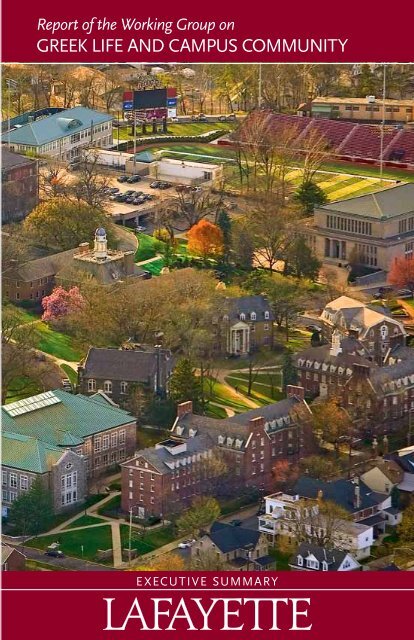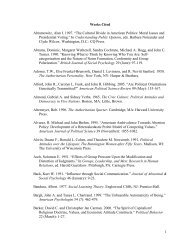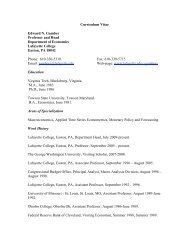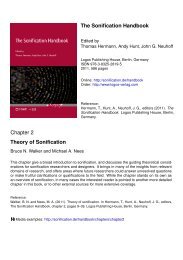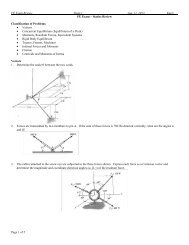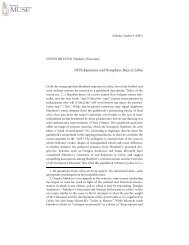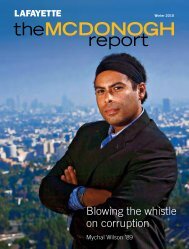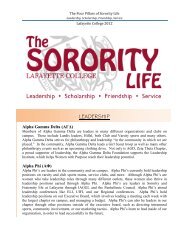GREEK LIFE AND CAMPUS COMMUNITY - Sites at Lafayette ...
GREEK LIFE AND CAMPUS COMMUNITY - Sites at Lafayette ...
GREEK LIFE AND CAMPUS COMMUNITY - Sites at Lafayette ...
You also want an ePaper? Increase the reach of your titles
YUMPU automatically turns print PDFs into web optimized ePapers that Google loves.
Report of the Working Group onGreek Life and Campus Communityexecutive summary1
1. Introduction and ChargeIn 2009, an Ad Hoc Committee on Residence Life undertook a review of<strong>Lafayette</strong>’s residence life program to provide direction as the College implementsthe Str<strong>at</strong>egic Plan and continues shaping the residential experience for students.The Ad Hoc Committee was chaired by Robert Sell ’84, Vice Chair of the TrusteeCommittee on Student Life. Its final report set forth 25 recommend<strong>at</strong>ionsfor consider<strong>at</strong>ion by College officials, three of which pertained specifically tofr<strong>at</strong>ernities and sororities. Although the Ad Hoc Committee did not set out tostudy the Greek system per se, the members thought it advisable to conduct ananalysis on the role of these groups.The Ad Hoc Committee on Residence Life sought the input of studentsthrough several Student Government forums and focus groups sponsored byStudent Government and of faculty and administr<strong>at</strong>ors through regular staff andcommittee meetings. In its final report, the Ad Hoc Committee summarized thehistory of fr<strong>at</strong>ernities and sororities <strong>at</strong> <strong>Lafayette</strong> College and recognized theirsignificant value to many current and former students. However, the membersalso voiced their concerns not all of the goals of the fr<strong>at</strong>ernity and sorority systemwere being met consistently across chapters.While the Greek community has a long history <strong>at</strong> <strong>Lafayette</strong>, there is clearlya need to revisit the purpose of these organiz<strong>at</strong>ions. While some tend todo well in the areas of recruitment, academic performance, communityservice, and philanthropy, they have found it challenging over time to adhereto College and n<strong>at</strong>ional policies rel<strong>at</strong>ed to new-member educ<strong>at</strong>ion andrisk management. In addition, fr<strong>at</strong>ernities and sororities are constantly inthe position of defending themselves against charges of elitism, a lack ofdiversity, and discrimin<strong>at</strong>ory membership-intake practices (Report of the AdHoc Committee on Residence Life, September 2009, p. 25).The Ad Hoc Committee also noted many non-Greek students, faculty, andadministr<strong>at</strong>ors had expressed concerns these groups were deleterious todeveloping the kind of academic community envisioned in the College’s Str<strong>at</strong>egicPlan. At the conclusion of its process, the Ad Hoc Committee expressed the“studied opinion th<strong>at</strong> resolution to the issue of how fr<strong>at</strong>ernities and sororities canmost effectively contribute to the College’s mission requires further study.”In response to the Ad Hoc Committee’s recommend<strong>at</strong>ion, President Weisscre<strong>at</strong>ed the Working Group on Greek Life and Campus Community with thefollowing charge:The objective of the Working Group on Greek Life and CampusCommunity is to understand more clearly the benefits of sorority andfr<strong>at</strong>ernity membership, so as to preserve and enhance these benefits whilesimultaneously working with the undergradu<strong>at</strong>es and alumni to mitig<strong>at</strong>ethe more problem<strong>at</strong>ic issues facing the chapters. The group will seek todetermine how best these organiz<strong>at</strong>ions can contribute to the College’sfuture by aligning their primary purposes and daily oper<strong>at</strong>ions withacademic excellence, diversity and inclusion, student learning outside of theclassroom, responsible use of controlled substances, personal integrity, andthe development of organiz<strong>at</strong>ions th<strong>at</strong> both support and challenge theirmembers to grow and develop.Many colleges and universities have carried out similar reviews of their Greeksystems during the past decade. The Working Group is indebted to colleagues<strong>at</strong> Bucknell University, Colg<strong>at</strong>e University, St. Lawrence University, Wake ForestUniversity, Princeton University, Lehigh University, Union College, and theCollege of William and Mary for sharing their reports and experiences with theWorking Group.The efforts of the Working Group were also informed by the so-called FranklinSquare Group of presidents, Greek organiz<strong>at</strong>ions, and higher educ<strong>at</strong>ionorganiz<strong>at</strong>ions, which issued a report in 2003 entitled A Call for Values Congruence.In his introduction to the report, Dr. Steffen Rogers, president emeritus ofBucknell University, st<strong>at</strong>ed the Franklin Square conferees “firmly believe th<strong>at</strong>rhetoric will m<strong>at</strong>ch reality when fr<strong>at</strong>ernity and sorority headquarters, hostcampuses, and students collabor<strong>at</strong>ively implement and assess practices andpolicies grounded in a shared set of standards.”The report recognizes Greek organiz<strong>at</strong>ions have the potential to make manypositive contributions to institutions of higher educ<strong>at</strong>ion, such as enhancingstudent learning and leadership, strengthening the connections betweenalumni and their colleges, and helping students to value community service andcitizenship, and many colleges have cre<strong>at</strong>ed “rel<strong>at</strong>ionship st<strong>at</strong>ements” describingthe expect<strong>at</strong>ions for Greeks and their host institutions. The conferees felt itwas necessary to convene their group because they did not believe the Greekcommunity had undergone the kind of transform<strong>at</strong>ive or system<strong>at</strong>ic change th<strong>at</strong>would help chapters align their behavior with their st<strong>at</strong>ed values (A Call for ValuesCongruence, p.4). They urged presidents to take a leadership role in helping theircampuses do the following:1. Strongly reaffirm the primacy of an academic culture for the campuscommunity and the importance of social organiz<strong>at</strong>ions, including Greeksystems, to sustaining th<strong>at</strong> culture.2. Articul<strong>at</strong>e collegi<strong>at</strong>e expect<strong>at</strong>ions for students groups, including theirresponsibility for the behavior of their membership.2 3
3. Encourage the development of programs and policies addressing alcoholabuse based upon research findings and established best practices andoversee their implement<strong>at</strong>ion.4. Establish a periodic “certific<strong>at</strong>ion process,” preferably conducted by orincluding represent<strong>at</strong>ion external to the campus, of all recognized socialfr<strong>at</strong>ernities and sororities. This site-visit process would focus on eachindividual chapter’s record of abiding by established policies and fulfillingenunci<strong>at</strong>ed expect<strong>at</strong>ions.5. Dedic<strong>at</strong>e the necessary resources to promote healthy lifestyles for allstudents and to encourage Greek organiz<strong>at</strong>ions to emphasize common corevalues.6. Seriously consider the adoption of a policy th<strong>at</strong> clearly specifies th<strong>at</strong>for a n<strong>at</strong>ional/intern<strong>at</strong>ional fr<strong>at</strong>ernity or sorority to have a chapter onthe campus, it must have adopted and implemented membership andbehavioral standards congruent with those adopted by the North-AmericanInterfr<strong>at</strong>ernity Conference and the N<strong>at</strong>ional Panhellenic Conference.Although the Working Group on Greek Life and Campus Community wascharged to focus solely on the Greek community, members were frequentlyasked why they were not examining other organiz<strong>at</strong>ions and aspects of campuslife. The College has engaged in numerous studies of its programs and servicesin recent years, including reviews of campus alcohol use in 1998 and 2011, a1999 review of its intercollegi<strong>at</strong>e <strong>at</strong>hletics program, a campus clim<strong>at</strong>e studyconducted in 2000, a 2003-04 study of the religious life program, and a reviewof student social p<strong>at</strong>terns completed in 2005-06. In addition, a working groupexamined <strong>at</strong>hletics scholarships during 2005-06, and in 2008-09, as referencedabove, an Ad Hoc Committee on Residence Life spent the full academic yearexamining th<strong>at</strong> program. During the time the Working Group on Greek Lifeand Campus Community was examining the College’s fr<strong>at</strong>ernity and sororityprograms, a second campus clim<strong>at</strong>e study was being conducted, and the Collegebegan reviewing its campus safety policies and practices. Typically, these reviewcommittees and working groups involve a wide array of College constituencies,including trustees, faculty, staff, students, and alumni.how well the Greek community was fulfilling its st<strong>at</strong>ed goals and to inform itsrecommend<strong>at</strong>ions.Fr<strong>at</strong>ernities and sororities share many things in common with other studentorganiz<strong>at</strong>ions, such as providing leadership development, valuing service, andoffering social activities, but they also differ in significant ways. The 2009 AdHoc Committee on Residence Life realized the uniqueness of fr<strong>at</strong>ernities andsororities <strong>at</strong> <strong>Lafayette</strong> College and thus believed they warranted special study.Nevertheless, the Working Group on Greek Life and Campus Communityendeavored to carry out this review in a manner th<strong>at</strong> would result inrecommend<strong>at</strong>ions th<strong>at</strong> would not only strengthen the Greek communitybut all student organiz<strong>at</strong>ions and social living groups <strong>at</strong> <strong>Lafayette</strong> College.The Working Group had the following objectives:1. Conduct a thorough review of the history of Greek life and <strong>Lafayette</strong> Collegeand develop a substantive understanding of the role the Greek system playson our campus.2. Examine the characteristics of fr<strong>at</strong>ernity and sorority systems <strong>at</strong> peerinstitutions.3. Study best practices on fr<strong>at</strong>ernity and sorority management as forwarded bythe N<strong>at</strong>ional Interfr<strong>at</strong>ernity Council and sponsor an external review of theCollege’s Greek system.4. Review the effectiveness of the COMPASS accredit<strong>at</strong>ion process for Greeklife.5. Review the College’s disciplinary process rel<strong>at</strong>ed to adjudic<strong>at</strong>ing themisconduct of fr<strong>at</strong>ernities and sororities.6. Review the new-member educ<strong>at</strong>ion program of fr<strong>at</strong>ernities and sororitiesand the subsequent impact of membership on academic performance andstudent engagement.The College also collects and examines, on a regular basis, compar<strong>at</strong>ive d<strong>at</strong>arel<strong>at</strong>ed to its students through the use of various survey instruments, includingthe N<strong>at</strong>ional Survey on Student Engagement, the Cooper<strong>at</strong>ive InstitutionalResearch Project, the <strong>Lafayette</strong> College Drug and Alcohol Survey, the NASPA/Student Voice Mental Health and Counseling Survey, and survey d<strong>at</strong>a obtainedon residential living from the Educ<strong>at</strong>ional Benchmarking Institute (EBI). TheWorking Group used inform<strong>at</strong>ion from many of these reports and surveys,as well as d<strong>at</strong>a collected by the Office of Institutional Research, to evalu<strong>at</strong>e4 57. Study the issue of inclusion and perceived exclusive member-intake practicesby fr<strong>at</strong>ernities and sororities.8. Evalu<strong>at</strong>e the potential contributions of historically Black/L<strong>at</strong>ino/Asianfr<strong>at</strong>ernities and sororities.9. Study fr<strong>at</strong>ernity and sorority membership composition: scholars, <strong>at</strong>hletes,underrepresented groups, etc.
10. Review the purpose, practices, and effectiveness of the AlumniInterfr<strong>at</strong>ernity and Sorority Board (AISB).11. Study the issue of chapter-house management and facility supervision.12. Contempl<strong>at</strong>e the development of learning outcomes and assessmentmeasures to be employed by these organiz<strong>at</strong>ions to document studentlearningoutcomes.13. Conduct candid convers<strong>at</strong>ions on hazing and the irresponsible use ofalcohol within fr<strong>at</strong>ernities and sororities.14. Review College staffing and support issues rel<strong>at</strong>ed to the administr<strong>at</strong>iveoversight of Greek organiz<strong>at</strong>ions.2. Membership and Inform<strong>at</strong>ion-G<strong>at</strong>hering ProcessComposition of the Working GroupThe Working Group was co-chaired by Barbara Levy ’77, chair of the TrusteeCommittee on Student Life, and Ashley Juavinett ’11, a neuroscience majorand former president of Student Government. Other members included alumniPaul McCurdy ’82, Trustee and past-President of the Alumni Associ<strong>at</strong>ion,and Kevin Canavan ’76, co-chair of the AISB; faculty members JamesSchaffer, Professor of Chemical and Biomolecular Engineering and Directorof Institutional Research, and John Shaw, Associ<strong>at</strong>e Professor of Psychology;and administr<strong>at</strong>ors James Krivoski, Executive Assistant to the President andformer Vice President for Student Life, Karen Forbes, Director of CounselingServices and Student Life Research, Laurel Peffer, Assistant Directorof Residence Life and Adviser to Fr<strong>at</strong>ernities and Sororities, and ShirleyRamirez, former Vice President for Diversity and Community Engagement.Other student members of the working group were Max Bass ’10 (Americanstudies), Thomas Benjamin ’12 (chemical engineering and government andlaw), Jennifer Cotennec ’11 (Executive Vice President of the PanhellenicCouncil and psychology major), Louis D’Angelo ’11 (former president of theInterfr<strong>at</strong>ernity Council and neuroscience major), Kyara Gray ’11 (economicsand business), Justin Kamine ’11 (economics and business/policy studies),Elizabeth K<strong>at</strong>z ’10 (past-President of Panhellenic Council and psychologymajor), and DeAndre Morrow ’10 (history).Activities of the Working GroupThe Working Group met 18 times, including two four-hour facilit<strong>at</strong>ion sessions,between October 2009 and April 2011, with 38 separ<strong>at</strong>e meetings held by theSteering Committee. President Weiss met intermittently with the SteeringCommittee and with the entire Working Group several times to review thecharge and discuss their progress. The group spent its time engaging the Collegecommunity in convers<strong>at</strong>ions rel<strong>at</strong>ed to the issues identified in the charge andcollecting st<strong>at</strong>istical inform<strong>at</strong>ion. Members <strong>at</strong>tended a webinar on Current Issuesin Greek Life by Drs. Joseph Bertolino and Emily Langdon on Values BasedEduc<strong>at</strong>ion in Greek Life and reviewed academic articles on fr<strong>at</strong>ernities andsororities. The Working Group also met with the following individuals and groups:• General Counsel and Vice President for Human Resources Leslie Muhlfelderto review laws rel<strong>at</strong>ing to single-sex organiz<strong>at</strong>ions in higher educ<strong>at</strong>ion• Varsity coaches and the Assistant Director of Athletics to understand therel<strong>at</strong>ionship between fr<strong>at</strong>ernity and sorority membership and Division I<strong>at</strong>hletics• Members of the Alumni Interfr<strong>at</strong>ernity and Sorority Board to learn about thestudy they were conducting concurrently with th<strong>at</strong> of the Working Group• Fr<strong>at</strong>ernity and sorority leaders• Faculty committees on Student Life and Diversity and other faculty members<strong>at</strong> an open forum• Greek advisers and administr<strong>at</strong>ors on the campuses of Union College andBucknell, Colg<strong>at</strong>e, and Lehigh Universities• Eve Riley, Executive Director of the N<strong>at</strong>ional Panhellenic Council• Ben Pendry, Vice President for Advancement of the North-AmericanInterfr<strong>at</strong>ernity Conference• Members of the general student body <strong>at</strong> an open forumIn April 2010, the Working Group engaged consultants from the North-AmericanInterfr<strong>at</strong>ernity Conference’s Fr<strong>at</strong>ernity and Sorority Coalition Assessment Projectto conduct a review of <strong>Lafayette</strong>’s fr<strong>at</strong>ernity and sorority system and to focus onidentifying ways to help the community engage in best practices as defined byn<strong>at</strong>ional fr<strong>at</strong>ernity and sorority organiz<strong>at</strong>ions. The coalition team members metwith groups and individuals from across the campus.The <strong>Lafayette</strong> College Alumni Interfr<strong>at</strong>ernity and Sorority Board also presented aset of recommend<strong>at</strong>ions to the Working Group.The Working Group enlisted the services of consultant Gretchen Pisanoof Sounding Board, Inc., who helped to review and synthesize the d<strong>at</strong>a ithad collected and to identify key themes th<strong>at</strong> would form the basis of itsrecommend<strong>at</strong>ions.WebsiteThe Working Group cre<strong>at</strong>ed a website to ensure all members of the Collegecommunity, including alumni, had an opportunity to share their opinions andsuggestions about the role of fr<strong>at</strong>ernities and sororities <strong>at</strong> <strong>Lafayette</strong> College.6 7
On the website was a brief survey containing seven open-ended questions. Allresponses were anonymous, and respondents had the opportunity to declinepermission for their comments to be included in the final report. Commentswere submitted by 905 individuals. The majority of respondents (621) were alumni,with 213 comments from current students, 32 from faculty, 7 from staff, 10 fromadministr<strong>at</strong>ors, and 22 from “other.” The Working Group did not set out to obtaina represent<strong>at</strong>ive sample of the <strong>Lafayette</strong> community. The survey commentsincluded in the report are the opinions of the respondents and were chosen toillustr<strong>at</strong>e the range of opinions expressed; no <strong>at</strong>tempt was made by the WorkingGroup to valid<strong>at</strong>e any of the claims being made.The <strong>Lafayette</strong> Greek System TodayAt present, the College recognizes five fr<strong>at</strong>ernities and six sororities, andapproxim<strong>at</strong>ely 40 percent of the current <strong>Lafayette</strong> upper-class popul<strong>at</strong>ion isaffili<strong>at</strong>ed with the Greek system. When first-year students (who are not permittedto affili<strong>at</strong>e) are included, the percentage of Greek students is 29 percent. Now th<strong>at</strong>the College offers a wide variety of extracurricular and co-curricular clubs andactivities as well as vastly improved dining, residential, and recre<strong>at</strong>ional facilities,students view the Greek system as an option r<strong>at</strong>her than the only viable socialaltern<strong>at</strong>ive on campus. There are currently five n<strong>at</strong>ionally-affili<strong>at</strong>ed fr<strong>at</strong>ernitiesand six sororities.Fr<strong>at</strong>ernitiesDelta Kappa EpsilonDelta UpsilonKappa Delta RhoPhi Kappa PsiZeta PsiSororitiesAlpha PhiAlpha Gamma DeltaDelta Delta DeltaDelta GammaKappa Kappa GammaPi Beta PhiThe current role of fr<strong>at</strong>ernities and sororities to enhance the social, intellectual,and cultural life <strong>at</strong> <strong>Lafayette</strong> College is summarized in their mission st<strong>at</strong>ement onthe College’s website:In partnership with the College, Greek chapters work to uphold theirfounding values of brotherhood/sisterhood, scholarship, leadership, andservice. Chapters are also charged with enhancing the quality of life forall students on campus by providing a wide range of opportunities formeaningful individual growth and development.3. Community EngagementMost chapters cite leadership development, philanthropy and service, andcareer networking as central to the mission of Greek organiz<strong>at</strong>ions, and theWorking Group heard from many individuals who reported feeling they had,indeed, received such benefits from their particip<strong>at</strong>ion. Many of the respondentsto the web survey expressed their views th<strong>at</strong> their involvement in Greekorganiz<strong>at</strong>ions had helped them develop life skills, such as time management,financial competency, and career networking, but it is unclear if all membershave an equal chance to take advantage of these learning opportunities.Although it appears many Greek students hold offices in their chapters and inother student organiz<strong>at</strong>ions, the Working Group was unable to determine theimpact of membership on leadership-skill development. COMPASS reportsof particip<strong>at</strong>ion in leadership training are not consistent across all chapters, soit is possible students are underrepresenting their <strong>at</strong>tendance <strong>at</strong> regional andn<strong>at</strong>ional leadership conferences. However, the r<strong>at</strong>e of particip<strong>at</strong>ion appears lowerthan expected, given the emphasis on leadership development in most chapters’mission and values st<strong>at</strong>ements.Most of the inform<strong>at</strong>ion about career networking benefits is also anecdotal.Represent<strong>at</strong>ives from the N<strong>at</strong>ional Panhellenic Conference and the North-American Interfr<strong>at</strong>ernity Coalition Fr<strong>at</strong>ernity and Sorority Assessment Projectemphasized the extensive network of alumni available for career support formembers, but they do not maintain actual research d<strong>at</strong>a on Greek membership inthe career search process.The most recent COMPASS d<strong>at</strong>a available to the Working Group (2009) showsan impressive amount of philanthropic and service activity conducted by theGreek community. However, particip<strong>at</strong>ion is uneven and dollar amounts raisedranged from $50 to $20,000. The average number of hours of service per studentwas 6.6 per year, which suggests most Greek students are not prioritizing service.There are, however, a disproportion<strong>at</strong>e number of Greek students who holdleadership positions with the Landis Community Outreach Center.The Working Group heard comments concerning the role of alumni giving. Someindividuals expressed the opinion the College was avoiding problems with theGreek community because they feared losing alumni support, and others st<strong>at</strong>edthey believed the College’s tre<strong>at</strong>ment of certain chapters had already resulted in a8 9
loss of financial support. The d<strong>at</strong>a provided by the Office of Development showGreek giving has historically been higher than non-Greek giving. Based on pastgiving p<strong>at</strong>terns, the development office has concluded any declines in giving aftera chapter leaves campus are generally short-lived, though they recommendedfurther d<strong>at</strong>a analyses to confirm this opinion.The Working Group recognizes the d<strong>at</strong>a on community-engagement activitiesare limited and incomplete, and the Greek community and the College couldbenefit from more system<strong>at</strong>ic record-keeping and evalu<strong>at</strong>ion to ensure chaptersare fulfilling their objectives in this regard. There is the potential for Greeks tobecome centers for leadership, philanthropy and service, and career prepar<strong>at</strong>ion,but the benefits are largely anecdotal <strong>at</strong> this time. Many Greek alumni expressed adesire to partner with the College in improving chapter performance with regardto community engagement.4. Academic ExcellenceFr<strong>at</strong>ernity and sorority houses have the capacity to provide outstanding livinglearningenvironments. Unfortun<strong>at</strong>ely, the d<strong>at</strong>a from the Office of InstitutionalResearch suggests there may be some aspects of membership th<strong>at</strong> hamperstudents’ academic performance, especially for fr<strong>at</strong>ernity men. In 1995, the facultyvoted to move the new-member recruitment and educ<strong>at</strong>ion period to the firstsemester of sophomore year in an <strong>at</strong>tempt to reverse the declines in the overallgrade-point average occurring for Greek students; this decline has persisted forfr<strong>at</strong>ernities.Students in Greek organiz<strong>at</strong>ions are less likely to have merit scholarships or topursue EXCEL, honors, and independent scholarly research than students whoare not members. Between 1999 and 2008, the percentage of Greeks particip<strong>at</strong>ingin these activities has declined while it has increased slightly among non-Greeks.The Working Group heard some Greek students voice their opinion th<strong>at</strong> lowerGPAs were the result of higher numbers of majors in engineering and the n<strong>at</strong>uralsciences. Greeks were not overrepresented in these majors; fr<strong>at</strong>ernity and sororitymembers were most likely to major in the social sciences.The EBI Resident Survey suggests Greek students value their houses for theopportunities they provide to engage in learning outside the classroom. Thereis gre<strong>at</strong> potential for Greeks to cultiv<strong>at</strong>e their houses as centers for scholarshipand intellectual discourse, in the spirit of the very first fr<strong>at</strong>ernity, Phi Beta Kappa.Such efforts might also help transform some of the perceptions expressed to theWorking Group th<strong>at</strong> the Greek community was anti-intellectual. The reportsof the 2009 Ad Hoc Committee on Residential Life and the North-AmericanInterfr<strong>at</strong>ernity Conference Fr<strong>at</strong>ernity and Sorority Coalition Assessment Projectrecognized the value of living-learning communities on college campuses. TheGreek community would benefit from refocusing its efforts on academicexcellence and supporting the academic mission of <strong>Lafayette</strong> College.5. Personal Integrity and ResponsibilityConduct and Social Living GroupsThe issue of group and individual responsibility for viol<strong>at</strong>ions of the Code ofConduct has been one of the most contentious issues faced by the WorkingGroup. The amount of historical d<strong>at</strong>a a dean or committee considers regardinggroup conduct history is an ongoing source of deb<strong>at</strong>e.In the spring of 2010 the College invited a consultant to review the Code ofConduct and to address this conflict specifically. Dr. John Wesley Lowery spenttime reviewing the document and also speaking with members of the campuscommunity. In evalu<strong>at</strong>ing conduct m<strong>at</strong>ters, decisions must be made about groupversus individual responsibility. Dr. Lowery made reference to a chapter fromthe 1992 book Rights, Freedoms and Responsibilities: A Continuing Agenda edited byRichard Mullendore and William Bryan. The chapter, written by Joe Buchananand D. Parker Young (p. 84), outlines six general principles of group responsibility.The six principles are as follows:1. Members of the group act in concert to viol<strong>at</strong>e university standards ofconduct.2. A viol<strong>at</strong>ion arises out of a group sponsored, financed, or endorsed event.3. A group leader(s) has knowledge of the incident before it occurs and fails totake corrective action.4. The incident occurs on the premises owned or oper<strong>at</strong>ed by the group.5. A p<strong>at</strong>tern of individual viol<strong>at</strong>ions is found to have existed without proper andappropri<strong>at</strong>e group control, remedy, or sanction.6. Members of a group act in concert, or the organiz<strong>at</strong>ion provides the impetus(probable cause) for viol<strong>at</strong>ion of university rules and regul<strong>at</strong>ions.Although more than a decade old, this paradigm of assigning group responsibilityfor individual behaviors is still applicable. The authors are clear to pointout organiz<strong>at</strong>ions are responsible for the actions of their members and the10 11
esponsibility to ensure rules and regul<strong>at</strong>ions are followed is the duty of everymember of the group. <strong>Lafayette</strong> College most clearly defines living-groupresponsibility as it rel<strong>at</strong>es to the alcohol policy, and since the overwhelmingmajority of viol<strong>at</strong>ions of policy for which groups are adjudic<strong>at</strong>ed center on thealcohol policy, this is a good place to find the definition. <strong>Lafayette</strong>’s StudentHandbook defines living-group events within the College’s alcohol policy. There arespecific guidelines for fr<strong>at</strong>ernities and sororities outlined, and the first two itemsof the policy define living-group events and living-group responsibility.Living-group events: Any activity for which the living group pays, directly orindirectly, constitutes an event sponsored by th<strong>at</strong> organiz<strong>at</strong>ion. Also, any eventor activity th<strong>at</strong> takes place in a living group’s house is the responsibility of theliving group. Living groups th<strong>at</strong> use any priv<strong>at</strong>e, off-campus facility to hostsocial events may be held accountable by the College for viol<strong>at</strong>ions of city andCommonwealth laws (Student Handbook 2010-11, p. 9).Living-group responsibility: A living group sponsoring an event isresponsible for ensuring th<strong>at</strong> the alcohol policy is observed, and it willbe held responsible for viol<strong>at</strong>ions of the policy by individuals, includingundergradu<strong>at</strong>es and alumni. Each case will be judged, however, based on theefforts of the organiz<strong>at</strong>ion to ensure compliance. Individuals who viol<strong>at</strong>ethese rules will also be held accountable, and, when appropri<strong>at</strong>e, bothindividuals and organiz<strong>at</strong>ions will be subject to disciplinary actions (StudentHandbook 2010-11, p. 9).When the current <strong>Lafayette</strong> College st<strong>at</strong>ements about living-group events andresponsibility are compared to those outlined by Buchanan and Young, thereappears a high degree of consistency between the threshold <strong>Lafayette</strong> College usesto determine group responsibility and the guidelines Buchanan and Young provideregarding group responsibility.A total of 59 formal actions against Greek organiz<strong>at</strong>ions have been recordedsince the year 2000. Additionally, during this time period, three organiz<strong>at</strong>ionsvoluntarily withdrew from campus pending conduct proceedings. Alcohol was afactor in nearly all conduct situ<strong>at</strong>ions for which formal or preemptive action wastaken. It appears the percentage of total sanctions for viol<strong>at</strong>ions of the Code ofConduct by affili<strong>at</strong>ed upper-class students has trended downward, <strong>at</strong> least for theperiod studied by the Working Group.The Working Group also obtained inform<strong>at</strong>ion on the disciplinary processesfor Greek organiz<strong>at</strong>ions used <strong>at</strong> Bucknell, Colg<strong>at</strong>e, and Lehigh Universities. Inessence, each school’s disciplinary process is roughly identical to th<strong>at</strong> of <strong>Lafayette</strong>College. Bucknell uses an interfr<strong>at</strong>ernity council judicial board to adjudic<strong>at</strong>eminor incidents of misconduct; this appeared to be the primary difference from<strong>Lafayette</strong>’s policy and procedures.The Fr<strong>at</strong>ernal Inform<strong>at</strong>ion and Programming Group (FIPG), the riskmanagementprogram for fr<strong>at</strong>ernities and sororities, also makes the assumptionthe chapter will be held responsible for the actions of individual members.Member fr<strong>at</strong>ernities and sororities are expected to comply with FIPG policiesin situ<strong>at</strong>ions in which the university policies are less restrictive (FIPG RiskManagement Manual, 2008, p. 9).High-Risk Alcohol UseHigh-risk alcohol use has been an ongoing concern <strong>at</strong> <strong>Lafayette</strong> College and <strong>at</strong>colleges and universities across the country. Self-report d<strong>at</strong>a collected over thepast decade has shown a consistent p<strong>at</strong>tern of heavier and more frequent alcoholconsumption among Greek students. COMPASS includes the expect<strong>at</strong>ionsstudents will particip<strong>at</strong>e in alcohol-educ<strong>at</strong>ion programs sponsored by the Collegeor by the chapters.The College collects d<strong>at</strong>a on students’ alcohol and drug use from a number ofsources, including the NASPA/Student Voice Mental Health and CounselingSurvey, the biannual <strong>Lafayette</strong> College Alcohol and Drug Survey, and theEduc<strong>at</strong>ional Benchmarking Institute’s Resident Survey. The Mental Healthand Counseling Survey (2010) included six questions on alcohol and drug use.Substantial differences were found between Greeks and non-Greeks on allalcohol-rel<strong>at</strong>ed questions.Hazing<strong>Lafayette</strong> College defines hazing as “any ceremony or practice which involvesmental or physical exhaustion or abuse or would in any way interfere with thestudents’ mental or physical ability to perform their work <strong>at</strong> <strong>Lafayette</strong> College.These rites must not reflect unfavorably upon either the group or the College orbe of a dangerous, rude, or demeaning n<strong>at</strong>ure” (Student Handbook 2010-11, p. 11).<strong>Lafayette</strong> does not have any quantit<strong>at</strong>ive inform<strong>at</strong>ion on the prevalence of hazingon our campus, though campus administr<strong>at</strong>ors do report receiving anonymousreports of hazing from parents and students and some respondents to the websurvey reported having experienced or witnessed hazing. Fr<strong>at</strong>ernity and sororitymembers are required to particip<strong>at</strong>e in hazing prevention educ<strong>at</strong>ional programssponsored by the College on an annual basis; 75 percent of members must be in<strong>at</strong>tendance. Comments from the web survey show a variety of opinions abouthazing, most of which were from alumni.12 13
GenderMost sororities and fr<strong>at</strong>ernities are prohibited by their n<strong>at</strong>ional organiz<strong>at</strong>ionsfrom becoming coeduc<strong>at</strong>ional. Ben Pendry, Vice President for Advancement ofthe North-American Interfr<strong>at</strong>ernity Conference, and Eve Riley, Chair of theN<strong>at</strong>ional Panhellenic Conference, confirmed th<strong>at</strong> groups would likely have theircharters revoked by their n<strong>at</strong>ional organiz<strong>at</strong>ions if they were to allow membersof the opposite sex to join. Although Title IX of the Educ<strong>at</strong>ion Amendments of1972 (20 U.S.C. § 1681-1688), st<strong>at</strong>es “. . . [n]o person in the United St<strong>at</strong>es shall, onthe basis of sex, be excluded from particip<strong>at</strong>ion in, be denied the benefits of, orbe subjected to discrimin<strong>at</strong>ion under any educ<strong>at</strong>ion program or activity receivingfederal financial assistance [including student loans],” the st<strong>at</strong>ute provides a listof exceptions to this general rule including one for social fr<strong>at</strong>ernities or sororities.According to §1681(a) (6) of the st<strong>at</strong>ute, this general prohibition “shall not apply tomembership practices . . . of a social fr<strong>at</strong>ernity or social sorority . . . which consistsprimarily of students in <strong>at</strong>tendance <strong>at</strong> an institution of higher educ<strong>at</strong>ion. . .” Thus,Title IX does not prohibit the presence or recognition of single-sex living groupson <strong>Lafayette</strong>’s campus.During open meetings and in personal communic<strong>at</strong>ions, some members of the<strong>Lafayette</strong> community voiced their objections to single-sex organiz<strong>at</strong>ions ascontrary to <strong>Lafayette</strong>’s non-discrimin<strong>at</strong>ion policy with regard to all other studentorganiz<strong>at</strong>ions, and they were concerned th<strong>at</strong> those who argued th<strong>at</strong> fr<strong>at</strong>ernitiesand sororities provided benefits above and beyond those offered by other groupswere depriving students from receiving those benefits on the basis of gender.Race and EthnicityAnalyses were conducted to determine whether the racial/ethnic distributionof students varied by membership in a fr<strong>at</strong>ernity or sorority. Analyses wereconducted on d<strong>at</strong>a from 1999 and 2008. The percentage of students of color whowere Greek increased between 1999 and 2008, however the percentages are stillwell below wh<strong>at</strong> would be expected based on their represent<strong>at</strong>ion in the Collegepopul<strong>at</strong>ion.In 1999, 4.80 percent of fr<strong>at</strong>ernity members and 12.15 percent of non-membersidentified themselves as racial/ethnic minorities; in 2008 the percentagesincreased to 9.15 percent of members and 20.21 percent of non-members.Members of ethnic and minority groups made up 2.46 percent of sororitymembership in 1999 and 7.95 percent in 2008; 10.56 percent of non-Greek femalestudents were racial or ethnic minorities in 1999 and 26.91 percent in 2008.SummaryThe membership of Greek organiz<strong>at</strong>ions appears to differ from the student bodyas a whole in several ways. Fr<strong>at</strong>ernity and sorority members are more likely tobe Caucasian, less likely to be receiving financial support, more likely to identifythemselves as C<strong>at</strong>holic, and less likely to feel isol<strong>at</strong>ed and alone. Fr<strong>at</strong>ernitymembers were also less likely to be varsity student-<strong>at</strong>hletes. Greek studentswere twice as likely to believe the Greek community contributed to a positivecampus clim<strong>at</strong>e as were non-Greeks. The groups are single-sex as requiredby their n<strong>at</strong>ional organiz<strong>at</strong>ions and they are exempt from non-discrimin<strong>at</strong>ionrequirements under Title IX.The Working Group was challenged to define the meaning of diversity and toinclude academic major, sexual orient<strong>at</strong>ion, and geography in our definition.As noted in the section on academic excellence, academic majors were notdistributed equally within the Greek community. There were few students whoidentified themselves as gay, lesbian, or bisexual in the Campus Clim<strong>at</strong>e Survey,however a slightly gre<strong>at</strong>er number of those students were non-Greek. TheWorking Group did not collect d<strong>at</strong>a on the geographic origins of students.Inform<strong>at</strong>ion about the perception Greeks are “exclusive” organiz<strong>at</strong>ions whosecriteria for membership were secretive and inconsistent was largely g<strong>at</strong>heredthrough the web survey and convers<strong>at</strong>ions with members of the <strong>Lafayette</strong>community. The Working Group heard from students of color and non-membersth<strong>at</strong> many did not feel welcome in Greek houses. Greeks who were very positiveabout their overall experience still commented they thought the process forrecruitment and selection needed to be improved and made more transparent.7. Recommend<strong>at</strong>ionsThe following recommend<strong>at</strong>ions are based on the findings of institutionalresearch; convers<strong>at</strong>ions with students, faculty, alumni, and administr<strong>at</strong>ors;web survey responses; the reports of the North-American Interfr<strong>at</strong>ernityConference Fr<strong>at</strong>ernity and Sorority Coalition Assessment Project andthe Alumni Interfr<strong>at</strong>ernity and Sorority Board; the report of the FranklinSquare group on Values Congruence; and research on best practices <strong>at</strong> otherinstitutions. After reviewing the inform<strong>at</strong>ion it collected, the Working Groupmet with consultant Gretchen Pisano of Sounding Board, Inc., to formul<strong>at</strong>epreliminary recommend<strong>at</strong>ions. Members of the Steering Committee solicitedrecommend<strong>at</strong>ions from the entire Working Group, which were incorpor<strong>at</strong>edinto the first draft. The Working Group met on five subsequent occasions beforearriving <strong>at</strong> the final draft. The Working Group was able to achieve consensuson most of the recommend<strong>at</strong>ions, though there is one on which a difference ofopinion remains.16 17
The changes being proposed are intended to transform the Greek community andto improve its rel<strong>at</strong>ionship with the College. Most of the recommend<strong>at</strong>ions areconsistent with those proposed by the college presidents of the Franklin SquareGroup in their report A Call to Values Congruence, which focuses on prioritizingacademic engagement, communic<strong>at</strong>ing behavioral expect<strong>at</strong>ions clearly, usingresearch-based approaches to reduce high-risk alcohol use and improve overallwell-being, and system<strong>at</strong>ic evalu<strong>at</strong>ion of chapters’ adherence to their ownmissions and to th<strong>at</strong> of the College. Central to the mission of <strong>Lafayette</strong> Collegeis its commitment to making its campus a diverse, inclusive, and welcomingenvironment for all students, faculty, staff, and alumni.Regardless of which recommend<strong>at</strong>ions the Board may choose to endorse, it isimper<strong>at</strong>ive a reasonable period of time be employed to assess the effectivenessof the changes made. System<strong>at</strong>ic assessment has become a requirement forthe accredit<strong>at</strong>ion of colleges and universities and for many of their programs.Anecdotes and personal opinions will not be sufficient to make importantdecisions regarding the impact of the recommend<strong>at</strong>ions. Students, alumni, andCollege officials must be given adequ<strong>at</strong>e time to adjust to changes in decades-oldpractices and to adopt new skills and behaviors before the changes are judged tohave been successful.The Working Group believes th<strong>at</strong> for these recommend<strong>at</strong>ions to be implemented,the Greek community must work cooper<strong>at</strong>ively with the College and with alumniand n<strong>at</strong>ional organiz<strong>at</strong>ions to achieve academic excellence, to become morediverse and inclusive, to live up to its ideals of personal responsibility and integrity,and to fulfill its mission of philanthropy, service, and leadership.Improving Rel<strong>at</strong>ionships between the College and the Greek CommunityThe Working Group recognizes it is vital for the College and the Greekcommunity to have a positive, open, and trusting working rel<strong>at</strong>ionship. Thefive fr<strong>at</strong>ernities and six sororities currently recognized by the College must besupported in a manner th<strong>at</strong> will provide them with optimal opportunity tosucceed in fulfilling the College’s mission and the purposes of their n<strong>at</strong>ionalorganiz<strong>at</strong>ions. Both the North-American Interfr<strong>at</strong>ernity Conference Fr<strong>at</strong>ernityand Sorority Coalition Assessment Report and the AISB membership articul<strong>at</strong>eda need for the College to acknowledge the existence of the Greek communityon campus and to make public its virtues. The Working Group concurs th<strong>at</strong>, asa significant part of campus life, this system should not be ignored or hidden bythe College but th<strong>at</strong> both the virtues and struggles of these organiz<strong>at</strong>ions shouldbe made transparent to assist students as they make decisions about becomingmembers of the Greek community. Therefore:1. The partnership between the College and the Alumni Interfr<strong>at</strong>ernity andSorority Board must be strengthened, with active involvement from recognizedorganiz<strong>at</strong>ions and the College. <strong>Lafayette</strong> should play a stronger role infacilit<strong>at</strong>ing the functioning of this organiz<strong>at</strong>ion.2. Inform<strong>at</strong>ion on Greek life <strong>at</strong> <strong>Lafayette</strong> should become fully representedthroughout the College’s public rel<strong>at</strong>ions efforts. The activities and advantagesof Greek life should be fully transparent in areas such as admissions, tours,Family Weekend, Alumni Reunion, etc.3. The College should maintain its web presence such th<strong>at</strong> a balanced perspectiveon each organiz<strong>at</strong>ion is offered to interested students and their parents.This balanced perspective would include each group’s mission and themany philanthropic and service projects each sponsors, the recent conducthistory and current disciplinary st<strong>at</strong>us of the groups, and each organiz<strong>at</strong>ion’saccredit<strong>at</strong>ion st<strong>at</strong>us (COMPASS or its equivalent) to afford prospectivenew members and parents the opportunity to make well-informed decisionsconcerning organiz<strong>at</strong>ional choices.4. The College must partner more closely with the n<strong>at</strong>ional organiz<strong>at</strong>ions ofour active chapters, such th<strong>at</strong> meaningful interaction, either in person or vi<strong>at</strong>eleconference, occurs each semester. These interactions should involve the VicePresident for Campus Life and Senior Diversity Officer, the Dean of Students,the College’s Greek Adviser, executives from the n<strong>at</strong>ional organiz<strong>at</strong>ions, andstudent leaders.5. The Working Group recommends College officials communic<strong>at</strong>e with theparents of students joining fr<strong>at</strong>ernities and sororities, perhaps through a Parents’Council, concerning the recruitment process, the new-member educ<strong>at</strong>ionprocess, and initi<strong>at</strong>ion (i.e., letter to parents on student selection to a chapter).6. The College should engage in convers<strong>at</strong>ions with alumni officials concerningbest practices for chapter-house management. While these residentialfacilities—fr<strong>at</strong>ernities, sororities, residence halls, off-campus houses—providediffering living-learning experiences for students, all must receive theappropri<strong>at</strong>e physical plant <strong>at</strong>tention from the College.7. The alumni advising for Greek organiz<strong>at</strong>ions must be improved, such th<strong>at</strong>advisers receive training from the College and the various n<strong>at</strong>ional organiz<strong>at</strong>ionsand performance-assessment becomes a part of this important role. Specificimprovements include providing <strong>at</strong> least two advisers per house, one havingbeen gradu<strong>at</strong>ed for a minimum of 10 years, and personal meetings withCollege officials <strong>at</strong> least twice per semester focusing on financial management,philanthropic activities, faculty involvement, and general chapter management.18 19
8. The Vice President for Campus Life and Senior Diversity Officer should secure/appoint additional staff resources to support the supervision and educ<strong>at</strong>ionalprogramming rel<strong>at</strong>ed to the College’s Greek Life program.The Greek Community as a Center for Academic Excellence and Innov<strong>at</strong>ionThe academic achievement of all students is a priority for the College.Unfortun<strong>at</strong>ely, the d<strong>at</strong>a suggest many Greek organiz<strong>at</strong>ions have not beensuccessful in making such academic excellence a priority. Of special concern isthe decline in fr<strong>at</strong>ernity GPA during the semester when recruitment and newmembereduc<strong>at</strong>ion occurs. This is an important m<strong>at</strong>ter th<strong>at</strong> requires the close<strong>at</strong>tention of the College, alumni leaders, and represent<strong>at</strong>ives from the n<strong>at</strong>ionalorganiz<strong>at</strong>ions. The Working Group believes the solutions to this problem will bestbe addressed through organiz<strong>at</strong>ional rewards th<strong>at</strong> cre<strong>at</strong>e a culture of academicpride, r<strong>at</strong>her than through punitive measures. This is a m<strong>at</strong>ter th<strong>at</strong> must befe<strong>at</strong>ured prominently in the revitalized accredit<strong>at</strong>ion program (COMPASS).9. The College should work with the Faculty Committee on Student Life todevelop a Tech Clinic model of new-member educ<strong>at</strong>ion, whereby faculty/staffmembers, with input from the n<strong>at</strong>ional organiz<strong>at</strong>ion, would work with thenew-member class to achieve established outcomes. At <strong>Lafayette</strong>, Tech Clinicsare hands-on courses th<strong>at</strong> bring together students from different majors to helpsolve real-world problems. This model could be configured in a manner th<strong>at</strong>would incorpor<strong>at</strong>e the strengths of this collabor<strong>at</strong>ion into the new-membereduc<strong>at</strong>ion process. The Group recognizes, if adopted, such a program wouldbe designed differently for different groups and might require differing timeperiods to complete. The Working Group recommends the current newmembereduc<strong>at</strong>ion period remain <strong>at</strong> three weeks in length, <strong>at</strong> least until theTech Clinic option is explored as a possible altern<strong>at</strong>ive.10. The College should institute a str<strong>at</strong>egy where fr<strong>at</strong>ernity and sorority chapterhouses will be scheduled on a regular basis for academic use and open to allon campus to particip<strong>at</strong>e in these activities. The Group imagines classesand seminars would be taught in the houses, lectures given, receptions held,films shown, academic discussions facilit<strong>at</strong>ed, etc. These facilities, with theassistance of alumni and undergradu<strong>at</strong>e members, can be transposed intoliving-learning centers important to the campus community, in a mannersimilar to wh<strong>at</strong> was proposed by the 2009 Ad Hoc Committee on ResidenceLife.11. The Working Group recommends, with the assistance of the FacultyCommittee on Student Life, the Greek life accredit<strong>at</strong>ion program, COMPASS,be reconsidered so it focuses on organiz<strong>at</strong>ional values alignment, specificlearning outcomes, and the assessment of those outcomes. Such a programmight differ for the various organiz<strong>at</strong>ions, as suggested by the NIC report, butpositive outcomes should be recognized and rewarded, while organiz<strong>at</strong>ionalfailure in this area should be addressed as well.12. Faculty and staff members who are full-time College employees should beencouraged to serve as advisers to fr<strong>at</strong>ernities and sororities, and they shouldreceive training and be rewarded for their efforts. These faculty and staffadvisers will work together as a steering council with house leaders to cre<strong>at</strong>ecommunity-wide programming hosted by the Greek organiz<strong>at</strong>ions. TheCollege should review staffing p<strong>at</strong>terns and financial resources to support thiscouncil and its efforts.Supporting a Diverse, Inclusive, and Welcoming Greek CommunityThe Campus Clim<strong>at</strong>e Study found the campus is divided in its opinion aboutthe impact of the Greek community on the campus as a positive and welcomingenvironment. The current membership does not reflect the diversity of thestudent body. The success of these organiz<strong>at</strong>ions is tied to College support, theirnew-member selection and educ<strong>at</strong>ion processes, and to others’ perceptions th<strong>at</strong>they are open, welcoming, and purposeful. The Working Group also recognizesthe current community lacks any represent<strong>at</strong>ion from historically Black, L<strong>at</strong>ino,and Asian fr<strong>at</strong>ernities and sororities. Therefore:13. College officials should work with fr<strong>at</strong>ernity and sorority alumni advisersand n<strong>at</strong>ional organiz<strong>at</strong>ion represent<strong>at</strong>ives to devise a recruitment system for<strong>Lafayette</strong> whereby these organiz<strong>at</strong>ions are open to any interested studentand do not discrimin<strong>at</strong>e in membership-intake beyond grade-point average,disciplinary standing, and other well-reasoned, transparent qualific<strong>at</strong>ions:transparency in new member selection criteria is the oper<strong>at</strong>ive concept. Thecriteria for each organiz<strong>at</strong>ion should be well-publicized.14. The College must enter into a partnership with alumni, parents, and n<strong>at</strong>ionalexecutives in framing the details of purposeful new-member educ<strong>at</strong>ionprograms. There should be a pre-approved new-member program calendar ofactivities, a new-member handbook needs to be developed and distributed aspart of the orient<strong>at</strong>ion, and represent<strong>at</strong>ives of the n<strong>at</strong>ional organiz<strong>at</strong>ion andthe alumni adviser must be present for and certify each group’s initi<strong>at</strong>ion.15. A fund should be developed and a process initi<strong>at</strong>ed to provide financial supportfor those who are unable to join Greek life and other student organiz<strong>at</strong>ionsdue to costs. The College, in coordin<strong>at</strong>ion with the AISB, should develop amechanism for funding this program through an assessment placed on chapteralumni and/or funding from the n<strong>at</strong>ional headquarters.16. The Working Group strongly recommends Greek organiz<strong>at</strong>ions offeralcohol-free social events (similar to DU spinning) open to the entire campus20 21
community and coordin<strong>at</strong>ed with the student life division, on a recurring basis.This is designed to provide additional social outlets for all students and to“open” the chapter houses in a way th<strong>at</strong> mitig<strong>at</strong>es their exclusive images. TheCollege should provide financial support for this recommend<strong>at</strong>ion.17. Chapters should place high priority on the successful launch of communityservice/service-learning initi<strong>at</strong>ives in partnership with the City of Easton andwithin the Easton community. Ideally, such philanthropic activities conductedby various chapters would be open to the general student body and wouldinvolve developing important ties between students, the organiz<strong>at</strong>ions, and thecity. Greek life programming must be more closely connected to the LandisCommunity Outreach Center staff to ensure coordin<strong>at</strong>ed and high-qualityservice experiences.18. College officials over time have heard passion<strong>at</strong>e testimony from multiculturalstudents th<strong>at</strong> existing Greek organiz<strong>at</strong>ions on campus do not fully meet theirneeds. The Working Group heard such reports as well. As <strong>Lafayette</strong> continuesto make diversity and inclusive excellence an institutional priority, the WorkingGroup was unanimous in encouraging the College to identify and put intoplace additional support structures th<strong>at</strong> optimize the experiences of allstudents. To this end, the Working Group recommends the College supportthose students who wish to join culturally based fr<strong>at</strong>ernities and sororitiesthrough regional or n<strong>at</strong>ional organiz<strong>at</strong>ions, through city-wide or metrochapters, or through a limited number of <strong>Lafayette</strong> recognized chapters, withthe understanding th<strong>at</strong> such organiz<strong>at</strong>ions comply with the recommend<strong>at</strong>ionsof the Working Group. Such initi<strong>at</strong>ives th<strong>at</strong> more fully address the needs of adiverse community, offer added value in providing opportunities not currentlyavailable on campus, and actively further the College’s diversity and inclusiongoals should receive immedi<strong>at</strong>e <strong>at</strong>tention.19. The Working Group recommends the College cre<strong>at</strong>e, in partnership with theAISB and n<strong>at</strong>ional organiz<strong>at</strong>ions, a leadership-development program for allnew members of fr<strong>at</strong>ernities and sororities. The Working Group anticip<strong>at</strong>esthis might present an opportunity for joint programming with other LehighValley institutions through the Lehigh Valley Associ<strong>at</strong>ion of IndependentColleges.Promoting Personal Integrity, Responsibility, andWell-Being in the Greek CommunityThroughout its review, the Working Group discussed important issues rel<strong>at</strong>edto the wellness of our students, such as alcohol and substance abuse, disorderede<strong>at</strong>ing, hazing, sexual misconduct, and behaviors rel<strong>at</strong>ed to general incivility.These problems are often associ<strong>at</strong>ed with fr<strong>at</strong>ernities and sororities, but it isclear they are not limited to these organiz<strong>at</strong>ions. Although for years the Collegehas engaged in efforts to address these issues, a re-conceptualiz<strong>at</strong>ion of how bestto move forward with this initi<strong>at</strong>ive is necessary. The Working Group is awarethere are currently campus groups reviewing the College’s approaches to alcoholeduc<strong>at</strong>ion and working on innov<strong>at</strong>ive and research-based interventions. Researchon high-risk alcohol consumption among college students suggests the mostsuccessful interventions are [1] student-driven, [2] address students’ perceptionsabout their peers’ behaviors and <strong>at</strong>titudes (i.e., social and injunctive norms), [3]involve parents, and [4] include environmental-management str<strong>at</strong>egies. TheWorking Group supports any policy changes th<strong>at</strong> will permit students, bothaffili<strong>at</strong>ed and nonaffili<strong>at</strong>ed, to use alcohol in a responsible and legal manner and inways th<strong>at</strong> comply with fr<strong>at</strong>ernity and sorority FIPG guidelines.Most of the disciplinary infractions involving Greek organiz<strong>at</strong>ions are rel<strong>at</strong>edto the illegal use or abuse of alcohol. The Working Group heard testimony th<strong>at</strong>the disciplinary history of organiz<strong>at</strong>ions – more than 4 years – might reflect thebehavior of students who are no longer undergradu<strong>at</strong>es <strong>at</strong> the College, and, thus,it can seem unfair to punish the organiz<strong>at</strong>ion for the behavior of past students.Simultaneously, the Group is aware these organiz<strong>at</strong>ions sometimes take on aneg<strong>at</strong>ive “group culture” th<strong>at</strong> germin<strong>at</strong>es over time and sustains itself despitethe efforts of the College, alumni, well-meaning individual students, or then<strong>at</strong>ional office to change it. Furthermore, the Working Group is aware of thechallenge in deciding whether viol<strong>at</strong>ions of the College’s Code of Conduct are theresponsibility of an individual, an organiz<strong>at</strong>ion, or both.Also, the Group is aware th<strong>at</strong>, <strong>at</strong> present, a pronounced gap exists betweenperception and reality rel<strong>at</strong>ed to how organiz<strong>at</strong>ional misconduct is adjudic<strong>at</strong>ed.Many affili<strong>at</strong>ed students and alumni view the College’s disciplinary process asflawed. However, College officials strive to follow best practices in this respect(and practices similar, if not identical, to our peer institutions). Therefore:20. The Working Group recommends the College reconfigure under acomprehensive wellness model its approach to alcohol and drug educ<strong>at</strong>ion,hazing prevention, healthy e<strong>at</strong>ing and exercise, and sexual misconducteduc<strong>at</strong>ion, focusing on positive lifestyle behaviors, to accompany the necessarypolicy-enforcement efforts. The Working Group anticip<strong>at</strong>es this effort willrequire the College to commit additional resources in the form of funding andpersonnel.21. Students should be involved in the planning and execution of alcohol-educ<strong>at</strong>ionand prevention activities. The Greek community should be encouraged andsupported in bringing a chapter of Gamma (Greeks Advoc<strong>at</strong>ing the M<strong>at</strong>ureManagement of Alcohol) to campus, but the College should also provideadequ<strong>at</strong>e advising so the group can be successful.22 23
22. The College should consider the adoption of the research-based on-lineprevention program Outside the Classroom, which includes modules on alcoholeduc<strong>at</strong>ion and sexual assault, as well as a module specific to the Greekcommunity. These programs could be used during new-student orient<strong>at</strong>ion andGreek new-member educ<strong>at</strong>ion. Colleges th<strong>at</strong> adopt Outside the Classroom receiveindividualized consult<strong>at</strong>ions about best practices and may <strong>at</strong>tend the AnnualResearch Institute.23. The Working Group recommends faculty members consider addressing theissue of high-risk alcohol within the curriculum, where it is appropri<strong>at</strong>e. TheGroup is aware th<strong>at</strong> the Office of the Provost and the Division of Student Lifeare developing a curriculum-infusion program, based on a successful effort<strong>at</strong> the University of Virginia, to use College survey d<strong>at</strong>a in courses as a way tounderstand and address such problems as high-risk alcohol use.24. The College must work with alumni advisers to address the issue oforganiz<strong>at</strong>ions moving their social events to off-campus loc<strong>at</strong>ions in order toprovide alcohol to minors (their own members and as a recruiting practice).25. The Working Group recommends the College particip<strong>at</strong>e in hazing-preventionorganiz<strong>at</strong>ions and conferences, such as the Novak Hazing PreventionConference <strong>at</strong> Lehigh University in June 2011. Current members and newmembers should be required to sign a hazing contract. The College shouldestablish a Hazing Tip Line to provide a mechanism for students, parents, andothers to report hazing being conducted by any type of campus organiz<strong>at</strong>ion.The Working Group recommends the College’s response to hazing of any kind,by any type of student organiz<strong>at</strong>ion, be unequivocal and substantive. Thereshould be no tolerance for hazing, and communic<strong>at</strong>ion from the College on thisissue must be thorough and frequent (through faculty, staff, coaches, advisers,alumni, etc.). Finally, the College must involve parents of students in its effortsto educ<strong>at</strong>e students regarding hazing.26. While the Working Group recommends the College ensure it continuesto observe best practices in the adjudic<strong>at</strong>ion of student/organiz<strong>at</strong>ionalmisconduct, it also recognizes <strong>Lafayette</strong> must seek ways to communic<strong>at</strong>emore effectively its policies and practices and, when reasonably possible, howindividual/ group misconduct has been adjudic<strong>at</strong>ed. The Group understandsth<strong>at</strong> when appropri<strong>at</strong>e, individual students should be held accountable formisconduct, and not an organiz<strong>at</strong>ion; when appropri<strong>at</strong>e, organiz<strong>at</strong>ions aloneshould be held accountable; and when appropri<strong>at</strong>e, both individuals andorganiz<strong>at</strong>ions should be held accountable. More transparent communityeduc<strong>at</strong>ion on this m<strong>at</strong>ter is in order.27. The Faculty Committee on Student Conduct, which adjudic<strong>at</strong>es cases of seriousorganiz<strong>at</strong>ional misconduct, must be trained to consider organiz<strong>at</strong>ional-conducthistories in a manner th<strong>at</strong> ensures organiz<strong>at</strong>ions are tre<strong>at</strong>ed fairly while theinterests of the College community are maintained as well. It is the sense of theWorking Group th<strong>at</strong> the Adviser to Fr<strong>at</strong>ernities and Sororities should play a rolein the training of this committee, and alumni leaders could be more engagedin the disciplinary process. Finally, groups should be provided with incentives/recognition for commendable organiz<strong>at</strong>ional and individual disciplinary records,perhaps through the Hoff Awards program.28. The Working Group supports the cre<strong>at</strong>ion of Interfr<strong>at</strong>ernity Counciland Panhellenic Council Judicial Boards—as recommended by the NICCoalition Assessment Team and AISB—for the purpose of adjudic<strong>at</strong>ing minororganiz<strong>at</strong>ional viol<strong>at</strong>ions of the College’s Code of Conduct, Commonwealth law,and policies of the various n<strong>at</strong>ional organiz<strong>at</strong>ions.29. The Working Group recommends, as described in the Coalition AssessmentTeam Report, the College’s senior student affairs officer consider a staffingconfigur<strong>at</strong>ion whereby the Adviser to Fr<strong>at</strong>ernities and Sororities reports throughthe Department of Student Life Programs, so as to separ<strong>at</strong>e further his/herassoci<strong>at</strong>ion with the student-conduct system and adjudic<strong>at</strong>ion process and toconnect more closely with th<strong>at</strong> department’s leadership-educ<strong>at</strong>ion programs.College Recognition and Assessment of Greek Organiz<strong>at</strong>ionsThe Working Group encountered substantial bifurc<strong>at</strong>ion of opinion regarding thenumber of fr<strong>at</strong>ernities and sororities th<strong>at</strong> should exist <strong>at</strong> <strong>Lafayette</strong>. While there isstrong opinion within the College community th<strong>at</strong> no additional groups should berecognized, and even th<strong>at</strong> the current system should be abolished altogether, manyalumni affili<strong>at</strong>ed with Greek organiz<strong>at</strong>ions advoc<strong>at</strong>e for additional groups. Indeed,the Working Group did not reach consensus on this issue. Some members opineth<strong>at</strong> the future of the College’s student-life program should not include additional,traditional fr<strong>at</strong>ernities and sororities, while others would reserve judgment onthis issue until the Working Group’s recommend<strong>at</strong>ions have been implementedand their impact evalu<strong>at</strong>ed. Two minority opinions exist within the group, one forabolition and one for more flexibility in considering expansion of the system. Overthe past decade, the College has focused its efforts on <strong>at</strong>tempting to enhance thequality of fr<strong>at</strong>ernity and sorority life r<strong>at</strong>her than adding to quantity, so th<strong>at</strong> existinggroups are programm<strong>at</strong>ically and organiz<strong>at</strong>ionally strong, while <strong>at</strong> the same timemeeting student demand for other types of special-interest living groups andincorpor<strong>at</strong>ing these into the College’s residential program.24 25
In any event, it makes sense th<strong>at</strong> the first order of business should be for theCollege to implement the Working Group’s recommend<strong>at</strong>ions and to assesssystem<strong>at</strong>ically their effectiveness over a period of time. This assessment shouldprovide direction to the Board of Trustees regarding the future configur<strong>at</strong>ion ofGreek life on campus. Therefore:30. Upon acceptance of this report and approval of its recommend<strong>at</strong>ions, animplement<strong>at</strong>ion committee should be appointed to cre<strong>at</strong>e a Time andResponsibility Grid. This committee, which should include or report tothe Faculty Committee on Student Life and the new Vice President forCampus Life and Senior Diversity Officer, will oper<strong>at</strong>e <strong>at</strong> ground level andbe responsible for ensuring the details of the recommend<strong>at</strong>ions are movedforward. Ultim<strong>at</strong>ely, the committee will report on its work to the TrusteeCommittee on Student Life.31. An oversight committee consisting of various College constituents, includingfaculty, staff, students, and alumni, should be convened to assess theeffectiveness of these recommend<strong>at</strong>ions. This committee will focus on thedesired outcomes of this study and the assessment of those outcomes. Theresults should be used to guide the future of Greek life <strong>at</strong> the College.26 27


